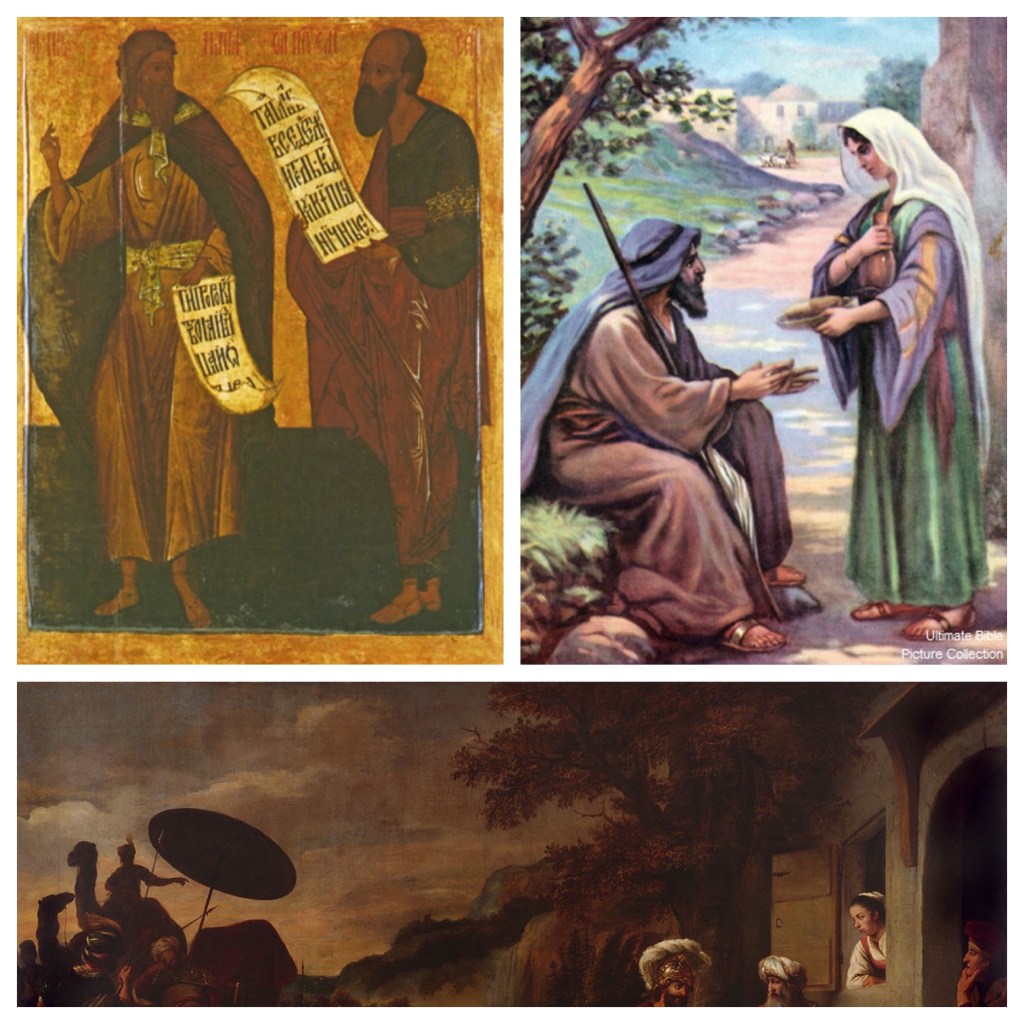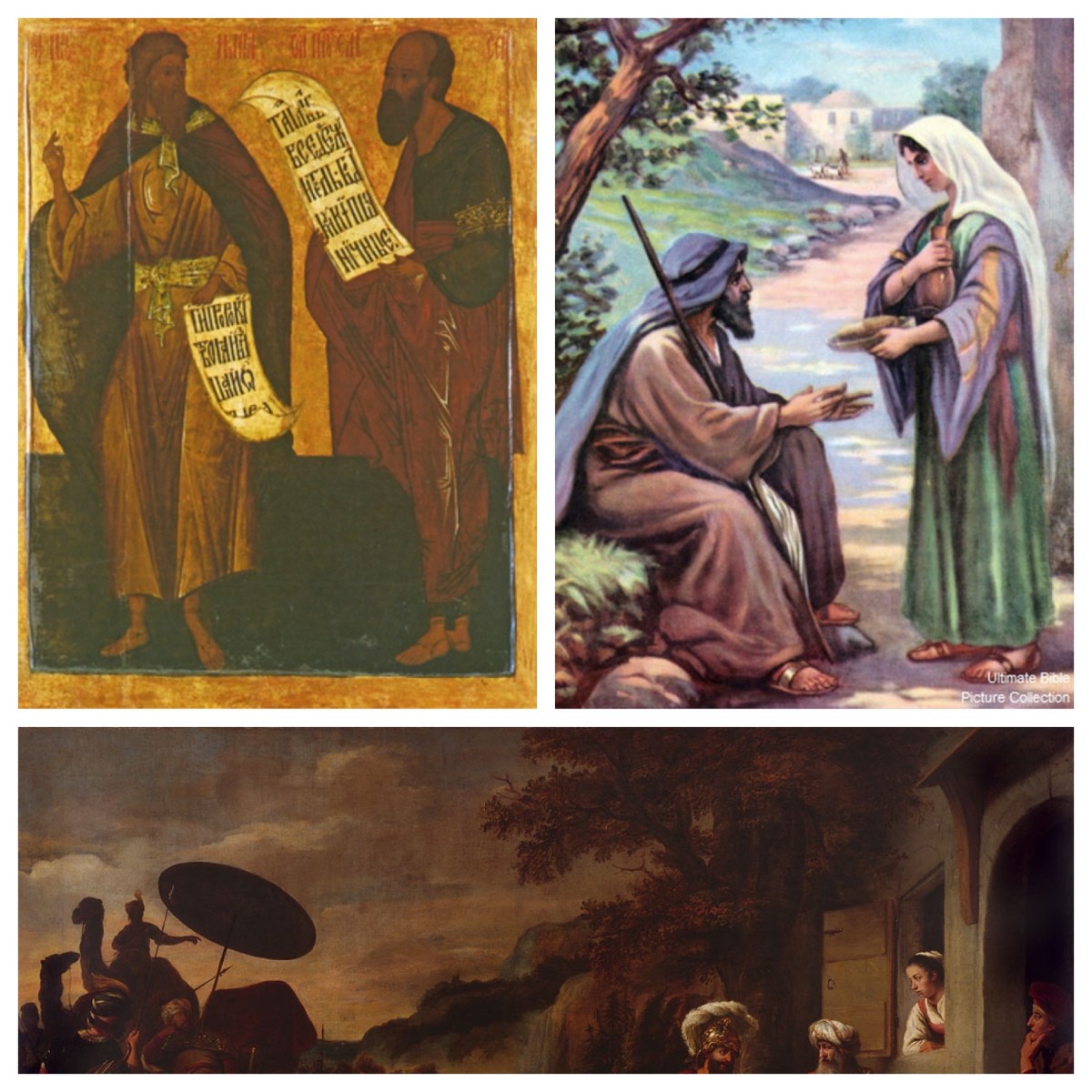We have seen how the two faithful followers to whom Jesus referred in his sermon in Nazareth differ from one another (in terms of gender and social status). We have also noted the way in which they are similar, as characters who are displaced from the mainstream of society. See https://johntsquires.com/2022/01/24/jesus-the-widow-of-sidon-and-the-soldier-of-syria-representatives-of-the-community-of-faith-luke-425-27-epiphany-4c/
Now, we consider all four faithful figures together. There are two faithful Gentiles: one from Sidon, another from Syria. Each of these individuals receives and responds to a faithful Jewish prophet, respectively Elijah and Elisha. Taken together, the four figures stand for another dimension of the inclusiveness of the community of the faithful: both Jews and Gentiles are part of this community.

For Luke, this theme assumes a place of high importance, and comes to dominate especially the second volume of his work, the Acts of the Apostles. The verse which is often cited as being the key to this volume is the declaration of Jesus, “you will be my witnesses in Jerusalem, in all Judea and Samaria, and to the ends of the earth” (Acts 1:8). Such a movement of the mission can be systematically traced throughout the work, from the centre of Judaism (chs. 1–7), into Samaria (ch. 8), on into various hellenised Jewish communities (chs. 9–11), then throughout the Diaspora (chs. 13–21) and on to the capital of the Roman Empire (ch. 28).
Three times in the course of preaching to Jews in the Diaspora, Paul announces that he is turning from the Jews and taking the Gospel to the Gentiles (Acts 13:44–49; 18:5–6; 28:23–28). These announcements seem to be symbolic of the broadening scope of the church, beyond the Jewish world, into Gentile arenas. Yet Paul continues preaching to Jews as well as Gentiles.
After his declaration in Antioch that he is turning to the Gentiles, he persists in returning to the synagogue when he visits Iconium (14:1), Thessalonica (17:1), Beroea (17:10), Athens (17:17) and Corinth (18:4). After a similar declaration in Corinth, he twice visits the synagogue in Ephesus (18:19; 19:8). Even though he announces in Rome that “the Gentiles will listen”, in contrast to the Jews whose ears are blocked, he continues to preach to “all who came to him” in that city (28:30–31). In context, this comment must refer to both Jews and Gentiles.
Even when he reaches Rome, the capital of the Empire and the symbolic heart of the Gentile world, Paul deliberately meets with “the local leaders of the Jews” (28:17). His mission is resolutely oriented towards Jews and Gentiles alike. The great breakthrough in this regard has come when the story of Peter and Cornelius is told (10:1–11:18). Luke takes great pains to underline the significance of these events.
Four times the narrative indicates that what happens to the Gentiles who are gathered in Caesarea is of the same order as what happened to the Jews who were gathered in Jerusalem at Pentecost. Peter declares that they “have received the Holy Spirit just as we have” (10:45), that “the Holy Spirit fell on them just as it had upon us at the beginning” (11:15), and that “God gave them the same gift that he gave us when we believed” (11:17). The council gathered in Jerusalem thus concludes that “God has given even to the Gentiles the repentance that leads to life” (11:18). For Luke, there is no doubt that the community of believers incorporates Gentiles on an equal footing with Jews.
And so it is that, when Paul narrates his ‘conversion’ on the road to Damascus, he reports that the commission which he received was to “be a witness to all the world” (22:15). This global mission field has already been specified, in Luke’s initial narrative of the incident, in God’s charge to Paul to be “a chosen instrument, to bring my name before Gentiles and kings and the people of Israel” (9:15).
The same global vision has already been made clear, however, long before Paul’s Damascus road encounter. In Luke’s report of the preaching of John the baptiser, the prophetic vision was already in view: “all flesh shall see the salvation of God” (Luke 3:6, citing Isa 40:5). And even at the moment when the spirit-inspired Simeon holds the infant Jesus in his arms, he speaks of God’s salvation as being “a light for revelation to the Gentiles and for glory to your people Israel” (2:32).
The universal implications of the Gospel are thus in view from the very earliest stages of Luke’s first volume. Specific indicators of this in the first volume are relatively rare. The crowds from Tyre and Sidon who listen to Jesus’ teachings are Gentiles (6:17), as is the centurion who exhibits great faith (7:1–10). The mission of the seventy-two disciples (10:1–20) may allude to the Gentile mission begun in the Acts of the Apostles. The centurion who exhibits sympathy for Jesus at the moment of his death (23:47) is, of course, a Gentile. Yet the course has been clearly set by the Lukan Jesus for the ultimate inclusion of Gentiles into the people of God.
Having noted these explicit statements and implicit portrayals of Jewish- Gentile relations, then, when we return to the incident in the synagogue in Nazareth, we can see the symbolic significance of the figures to whom Jesus referred. He speaks of two Jewish people, each linked with a Gentile person. Each connection is a microcosm of the faithful community. Luke has carefully shaped the sermon of Jesus so that it delicately prefigures the faith community which is created in the second volume of his work—a community in which Jews and Gentiles belong together.
One final comment remains to be made concerning the possible symbolic significance of Jesus’ reference to Elijah and the widow of Zarephath. Elijah is sent to her in a time of famine. The biblical account of this meeting reports how the Gentile widow was commanded to set before the Jewish prophet a jar of meal to eat and a jug of oil to drink (1 Kings 17:8–16). Implicit in the story is the sharing of food across what was, for the Jew, a clearly-defined boundary. This is precisely the issue which is at the heart of the events which draw Peter and Cornelius together (Acts 10:1–11:18).
The vision seen three times by Peter (10:9–16; 11:5–10) communicates the breakdown of the Levitical food laws, so that foods were no longer to be classified into ‘clean’ and ‘unclean’ categories. This opened up the possibility of Jews and Gentiles sharing table fellowship together. This is indeed what takes place, when hospitality (a place to sleep—and presumably food to eat) is offered by the Jew, Peter, to Gentile messengers in Joppa (10:23); and then by the Gentile, Cornelius, to Jewish believers in Caesarea (10:48).
It is for this reason that the Peter-Cornelius story is such a watershed in the narrative. It makes explicit what has previously been implicit; in it, Luke argues that God now acts to bring together those who have previously been held apart by divinely-sanctioned laws. In the light of this incident, then, the table fellowship enjoyed by Jesus in Luke’s Gospel takes on an added significance. See https://johntsquires.com/2019/05/22/jesus-and-his-followers-at-table-in-lukes-orderly-account/ and https://johntsquires.com/2019/05/08/resurrection-life-economic-responsibility-and-inclusive-hospitality-markers-of-the-gospel-acts-9/

